I wish to thank my parents, Robert and Carol Leshner, and my sister, Michelle, for their encouragement and continued support.
Maurice Childs for his extraordinary photography.
My editor Mary Sieber, designer Marilyn McGrane, and editorial director Paul Kennedy.
Introduction

At a very young age, I fell in love with antique and vintage jewelry. The 1920s through the 1940s gave us wonderful pieces of jewelry made of all types of white metal and rhinestones. It is a world within itself, full of history, beauty, and mystery. Costume jewelry is reflective of the times as well as social and aesthetic movements. Each piece tells its own story through hidden clues that, when interpreted, will help solve the mysteries surrounding them.
The jewelry is at times rich and elegant and at other times ornate yet simple. The pieces range in size and vary from delicate to bold. Whether you are looking for elaborate pieces or simple beauty, you are able to find it in the jewelry made during this time period. As a collector, dealer, or someone who has inherited a piece of old jewelry, you may have several questions that you want answered. What it is made of, what is the history behind the piece, how old is it, and the most common question what is it worth? By providing examples and historical information, this book will answer these often asked questions.  Double bird brooch, pot metal and clear and pink rhinestones, faux pearls, enameling, $185.
Double bird brooch, pot metal and clear and pink rhinestones, faux pearls, enameling, $185. 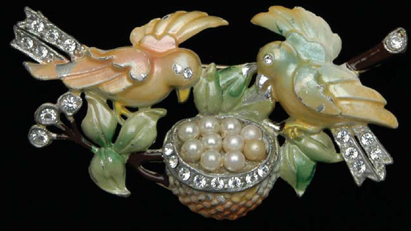 Double bird brooch, pot metal and clear rhinestones, faux pearls, enameling, $165.
Double bird brooch, pot metal and clear rhinestones, faux pearls, enameling, $165.  Double bird brooch, pot metal and clear rhinestones, faux pearls, enameling, $165.
Double bird brooch, pot metal and clear rhinestones, faux pearls, enameling, $165.
When you are collecting vintage jewelry, you need to focus on several things: condition, price, quality, scarcity/rarity, age, and design. Is the piece well made? Is it missing any stones or pieces? Can the piece be repaired, and how much will the repair cost? Are the stones hand set? Is the piece stamped or cast? These are all questions that you need to ask yourself when you are purchasing a piece of jewelry. To do this, one of the most important tools that you need is a loupe. A loupe is an instrument that allows you to see detail in the jewelry. It magnifies the object that you are looking at. Loupes come in varying sizes and magnifications.
The average magnification level that most people use is a 10X, which means that the magnification will be ten times the actual size. To use the loupe, hold it about an inch away from your eye, and then bring the object that you want to look at up to the loupe until you see it in focus. Be sure to keep both eyes open to view the item.
- Condition is first and foremost. Don't overlook this.
- Price is always a consideration, but the first rule of collecting is to collect what you like! Don't worry about trends or what's the hot new collectible.
- Price is always a consideration, but the first rule of collecting is to collect what you like! Don't worry about trends or what's the hot new collectible.
Focus on amassing a collection that makes you smile, that intrigues you, that inspires you. Whatever type of jewelry you buy, buy what you like, and buy the best examples of what you like that you can afford.
- The quality of the piece is also important. Look at the design of the piece. Is it intricate and ornate? Is it handmade or machine made? How is the finish on the piece? The more detail that is involved and the more handwork that is involved will generally make a piece of jewelry more valuable.
- The factor of the design of the piece is a more subjective personal evaluation.
- The factor of the design of the piece is a more subjective personal evaluation.
It has more to do with your own personal taste. However, the design of the piece can help you determine its age and identify the period and style.
- Scarcity and rarity play a role in the price of a piece. Obviously, if a piece of jewelry is rare and hard to find, the price will reflect it. But if a dealer has multiples of the same piece, be wary. These items can be old store stock or reproductions.
In either case, when multiples are available, the price should not be high.
White Metal and Rhinestone Jewelry 1920s, 1930s, and 1940s
Costume jewelry was an outgrowth of the desire of the average person to have copies of gemstone and precious metal jewelry that had previously been reserved for the wealthy. Costume jewelry began its steady ascent to popularity in the 1920s. Since it was relatively inexpensive to produce, there was mass production. The sizes and designs of the jewelry varied. Often, it was worn a few times, disposed of and then replaced with a new piece.
It was thought of as expendable a cheap throwaway to dress up an outfit. Costume jewelry became so popular that it was sold in upscale stores as well as the five-and-dime. Even though the cost was relatively low, each piece brought pleasure to its wearer. The designs had an intrinsic beauty that made them unique and special. The designs ranged from the subtle to the outrageous. Because of the relatively inexpensive production costs, designers were able to unleash their creativity while at the same time maintain high production standards.

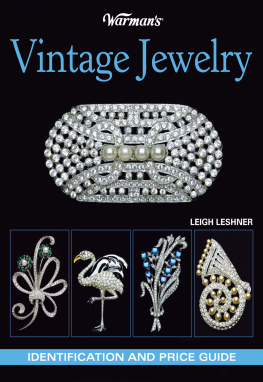




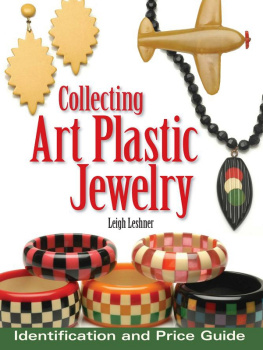

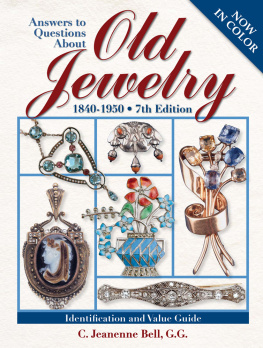





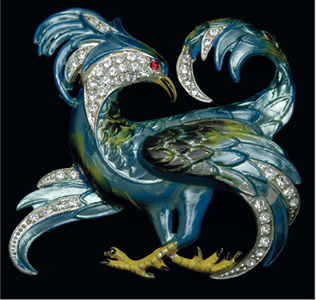 LEIGH LESHNER 2008 Leigh Leshner Published by
LEIGH LESHNER 2008 Leigh Leshner Published by  Our toll-free number to place an order or obtain a free catalog is (800) 258-0929. All rights reserved. No portion of this publication may be reproduced or transmitted in any form or by any means, electronic or mechanical, including photocopy, recording, or any information storage and retrieval system, without permission in writing from the publisher, except by a reviewer who may quote brief passages in a critical article or review to be printed in a magazine or newspaper, or electronically transmitted on radio, television, or the Internet. Library of Congress Control Number: 2007942607 ISBN-13: 978-0-89689-639-0
Our toll-free number to place an order or obtain a free catalog is (800) 258-0929. All rights reserved. No portion of this publication may be reproduced or transmitted in any form or by any means, electronic or mechanical, including photocopy, recording, or any information storage and retrieval system, without permission in writing from the publisher, except by a reviewer who may quote brief passages in a critical article or review to be printed in a magazine or newspaper, or electronically transmitted on radio, television, or the Internet. Library of Congress Control Number: 2007942607 ISBN-13: 978-0-89689-639-0 Maurice Childs for his extraordinary photography.
Maurice Childs for his extraordinary photography.  At a very young age, I fell in love with antique and vintage jewelry. The 1920s through the 1940s gave us wonderful pieces of jewelry made of all types of white metal and rhinestones. It is a world within itself, full of history, beauty, and mystery. Costume jewelry is reflective of the times as well as social and aesthetic movements. Each piece tells its own story through hidden clues that, when interpreted, will help solve the mysteries surrounding them.
At a very young age, I fell in love with antique and vintage jewelry. The 1920s through the 1940s gave us wonderful pieces of jewelry made of all types of white metal and rhinestones. It is a world within itself, full of history, beauty, and mystery. Costume jewelry is reflective of the times as well as social and aesthetic movements. Each piece tells its own story through hidden clues that, when interpreted, will help solve the mysteries surrounding them.  Double bird brooch, pot metal and clear and pink rhinestones, faux pearls, enameling, $185.
Double bird brooch, pot metal and clear and pink rhinestones, faux pearls, enameling, $185.  Double bird brooch, pot metal and clear rhinestones, faux pearls, enameling, $165.
Double bird brooch, pot metal and clear rhinestones, faux pearls, enameling, $165.